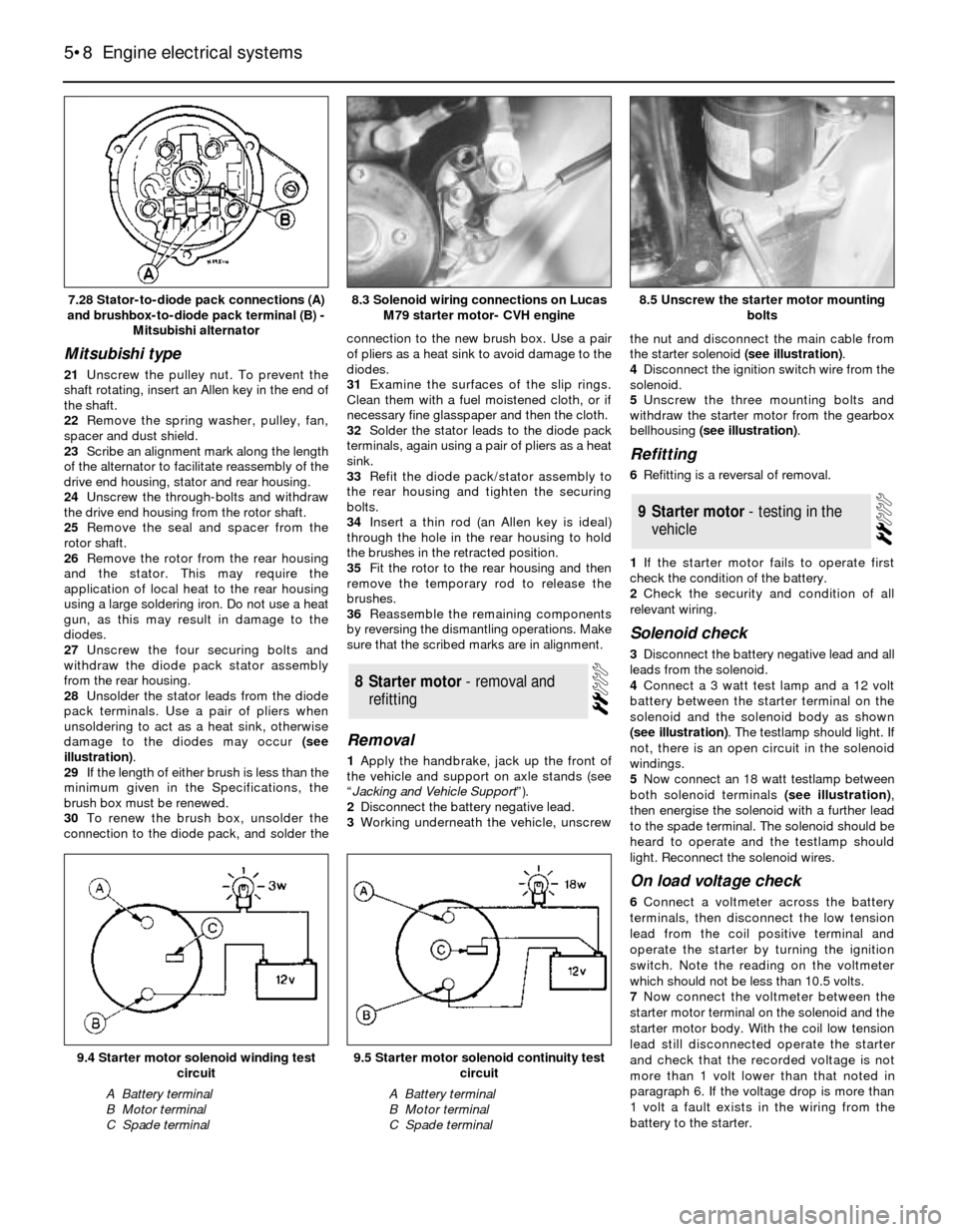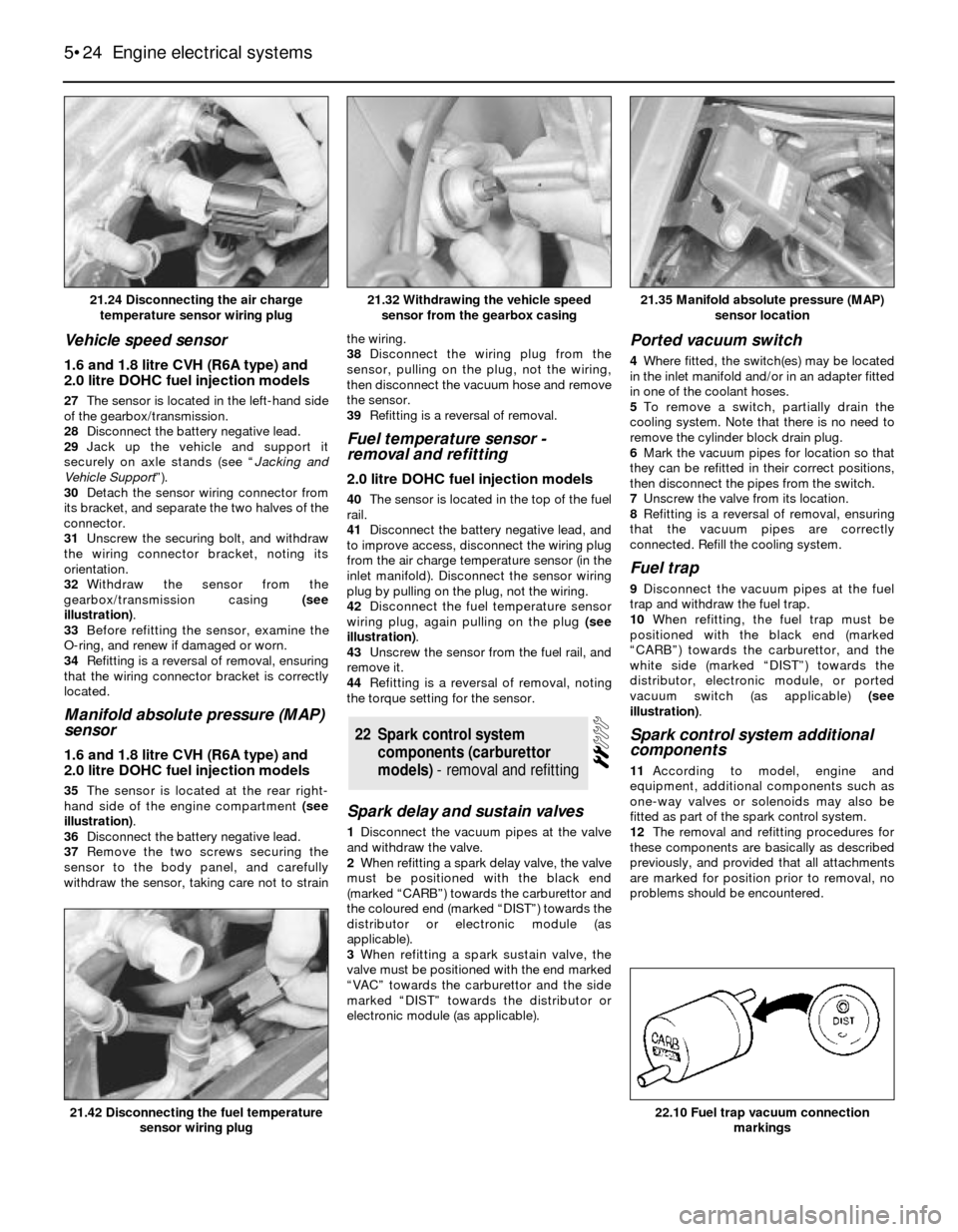gearbox FORD SIERRA 1992 2.G Engine Electrical Systems Workshop Manual
[x] Cancel search | Manufacturer: FORD, Model Year: 1992, Model line: SIERRA, Model: FORD SIERRA 1992 2.GPages: 24, PDF Size: 0.93 MB
Page 4 of 24

The ignition advance is a function of the
ESC II module, and is controlled by vacuum.
The module is connected to the carburettor
by a vacuum pipe, and a transducer in the
module translates the vacuum signal into an
electrical voltage. From the vacuum signal,
the module determines engine load; engine
speed and temperature are determined from
the crankshaft speed/position sensor and the
engine coolant temperature sensor. The
module has a range of spark advance settings
stored in its memory, and a suitable setting is
selected for the relevant engine speed, load
and temperature. The degree of advance can
thus be constantly varied to suit the prevailing
engine speed and load conditions.
ESC Hybrid (Electronic Spark Control
Hybrid) system
This system is fitted to 1.8 CVH models,
and comprises various sensors and an ESC
Hybrid module, in addition to the coil and
spark plugs. The distributor serves purely to
distribute the HT voltage to the spark plugs
and consists simply of a rotor arm mounted
directly on the end of the camshaft, and a
distributor cap.
The electrical impulse which is required to
switch off the low tension circuit is generated
by a crankshaft speed/position sensor which
is activated by a toothed wheel on the
crankshaft. The toothed wheel has 35 equally
spaced teeth with a gap in the 36th position.
The gap is used by the sensor to determine
the crankshaft position relative to TDC (top
dead centre) of No 1 piston.
Engine load information is supplied to the
ESC Hybrid module by a vacuum transducer
within the module which is connected to the
inlet manifold by a vacuum pipe. Additional
inputs are supplied by an inlet
manifold-mounted engine coolant temperature
sensor, and an air charge temperature sensor
mounted in the base of the air cleaner. The
module selects the optimum ignition advance
setting based on the information received from
the various sensors. The degree of advance
can thus be constantly varied to suit the
prevailing engine conditions.
In addition to the ignition circuit, the module
also controls an electric choke heater, and a
solenoid valve which in turn controls a throttle
damper on the carburettor. The electric choke
heater is operated by the module using
information supplied by the engine coolant
temperature sensor. The heater is used to
slow down the rate at which the choke comes
off, thereby improving driveability and overall
fuel consumption when the engine is cold. The
solenoid valve controls the vacuum supply to
the carburettor throttle damper. The throttle
damper prevents sudden closing of the throttle
during deceleration, thus maintaining
combustion of the air/fuel mixture which
reduces harmful exhaust gas emissions.
Note that there is no provision for
adjustment of ignition timing with the ESC
Hybrid system.
EEC IV (Electronic Engine Control IV)
system
2.0 litre SOHC fuel injection models
This system controls both the ignition and
fuel injection systems. The EEC IV module
receives information from a “Hall effect”
distributor sensor (similar to that described
previously in this Section for the ESC system),
an engine coolant temperature sensor
mounted in the inlet manifold, a throttle
position sensor, and an air flow meter.
Additionally, on models equipped with
automatic transmission and/or air
conditioning, additional inputs are supplied to
the module to allow it to raise the idle speed
to compensate for the additional engine load
imposed by the automatic transmission/air
conditioning. The module provides outputs to
control the fuel pump, fuel injectors, idle
speed, and ignition circuit. Using the inputs
from the various sensors, the EEC IV module
computes the optimum ignition advance, and
fuel injector pulse duration to suit the
prevailing engine conditions. This system
gives very accurate control of the engine
under all conditions, improving fuel
consumption and driveability, and reducing
exhaust gas emissions. A “limited operation
strategy” (LOS) means that the vehicle is still
driveable, albeit at reduced power and
efficiency, in the event of a failure in the
module or its sensors.
2.0 litre DOHC fuel injection models
A development of the EEC IV system is
used to control both the ignition and fuel
injection systems. The module receives
information from a crankshaft speed/position
sensor (similar to that described for the ESC
Hybrid system), except that the sensor is
activated by a toothed disc on the rear of the
crankshaft, inside the cylinder block), a
throttle position sensor, an engine coolant
temperature sensor, a fuel temperature
sensor, an air charge temperature sensor, a
manifold absolute pressure (MAP) sensor, and
a vehicle speed sensor (mounted on the
gearbox). Additionally, on models with a
catalytic converter, an additional input is
supplied to the EEC IV module from an
exhaust gas oxygen (HEGO) sensor. On
models with automatic transmission,
additional sensors are fitted to the
transmission, to inform the EEC IV module
when the transmission is in neutral, and when
the kickdown is being operated.
The module provides outputs to control the
fuel pump, fuel injectors, idle speed, ignition
system and automatic transmission.
Additionally, on models with air conditioning,
the EEC IV module disengages the air
conditioning compressor clutch when starting
the engine, and when the engine is suddenly
accelerated. On models fitted with a catalytic
converter, the EEC IV module also controls
the carbon canister-purge solenoid valve.
Using the inputs from the various sensors,
the EEC IV module computes the optimum
ignition advance, and fuel injector pulse
duration to suit the prevailing engine
conditions. A “limited operation strategy” (LOS)means that the vehicle is still driveable, albeit at
reduced power and efficiency, in the event of a
failure in the module or one of its sensors.
1.6 litre and 1.8 litre (R6A type) CVH models
A development of the EEC IV system is
used to control both the ignition and fuel
injection systems. A fully electronic
Distributorless Ignition System (DIS) is fitted,
replacing the mechanical distribution of high
tension voltage (by a rotating distributor) with
“static” solid-state electronic components.
The system selects the most appropriate
ignition advance setting for the prevailing
engine operating conditions from a three-
dimensional map of values stored in the EEC
IV control module memory. The module
selects the appropriate advance value
according to information supplied on engine
load, speed, and operating temperature from
various sensors.
The EEC IV module receives information
from a crankshaft speed/position sensor
(similar to that described for the ESC Hybrid
system), except that on 1.6 litre engines, the
sensor is activated by a toothed disc on the
flywheel), a throttle position sensor, an engine
coolant temperature sensor, an air charge
temperature sensor, a manifold absolute
pressure (MAP) sensor, a vehicle speed
sensor (mounted on the gearbox), and an
exhaust gas oxygen sensor.
The module provides outputs to control the
fuel pump, fuel injector, throttle valve control
motor, pulse-air control solenoid, carbon
canister purge solenoid (where applicable),
and the ignition system.
Using the inputs from the various sensors,
the EEC IV module computes the optimum
ignition advance and fuel injector pulse dura-
tion to suit the prevailing engine conditions. A
“limited operation strategy” (LOS) means that
the vehicle will still be driveable, albeit at
reduced power and efficiency, in the event of
a failure in the module or one of its sensors.
Precautions
General
It is necessary to take extra care when
working on the electrical system to avoid
damage to semi-conductor devices (diodes
and transistors), and to avoid the risk of
personal injury. In addition to the precautions
given in the “Safety first!” Section at the
beginning of this manual, take note of the
following points when working on the system.
Always remove rings, watches, etc before
working on the electrical system. Even with
the battery disconnected, capacitive
discharge could occur if a component live
terminal is earthed through a metal object.
This could cause a shock or nasty burn.
Do not reverse the battery connections.
Components such as the alternator or any
other having semi-conductor circuitry could
be irreparably damaged.
If the engine is being started using jump
leads and a slave battery, connect the
batteries positive to positive and negative to
negative. This also applies when connecting a
battery charger.
5•4Engine electrical systems
Page 8 of 24

Mitsubishi type
21Unscrew the pulley nut. To prevent the
shaft rotating, insert an Allen key in the end of
the shaft.
22Remove the spring washer, pulley, fan,
spacer and dust shield.
23Scribe an alignment mark along the length
of the alternator to facilitate reassembly of the
drive end housing, stator and rear housing.
24Unscrew the through-bolts and withdraw
the drive end housing from the rotor shaft.
25Remove the seal and spacer from the
rotor shaft.
26Remove the rotor from the rear housing
and the stator. This may require the
application of local heat to the rear housing
using a large soldering iron. Do not use a heat
gun, as this may result in damage to the
diodes.
27Unscrew the four securing bolts and
withdraw the diode pack stator assembly
from the rear housing.
28Unsolder the stator leads from the diode
pack terminals. Use a pair of pliers when
unsoldering to act as a heat sink, otherwise
damage to the diodes may occur (see
illustration).
29If the length of either brush is less than the
minimum given in the Specifications, the
brush box must be renewed.
30To renew the brush box, unsolder the
connection to the diode pack, and solder theconnection to the new brush box. Use a pair
of pliers as a heat sink to avoid damage to the
diodes.
31Examine the surfaces of the slip rings.
Clean them with a fuel moistened cloth, or if
necessary fine glasspaper and then the cloth.
32Solder the stator leads to the diode pack
terminals, again using a pair of pliers as a heat
sink.
33Refit the diode pack/stator assembly to
the rear housing and tighten the securing
bolts.
34Insert a thin rod (an Allen key is ideal)
through the hole in the rear housing to hold
the brushes in the retracted position.
35Fit the rotor to the rear housing and then
remove the temporary rod to release the
brushes.
36Reassemble the remaining components
by reversing the dismantling operations. Make
sure that the scribed marks are in alignment.
Removal
1Apply the handbrake, jack up the front of
the vehicle and support on axle stands (see
“Jacking and Vehicle Support”).
2Disconnect the battery negative lead.
3Working underneath the vehicle, unscrewthe nut and disconnect the main cable from
the starter solenoid (see illustration).
4Disconnect the ignition switch wire from the
solenoid.
5Unscrew the three mounting bolts and
withdraw the starter motor from the gearbox
bellhousing (see illustration).
Refitting
6Refitting is a reversal of removal.
1If the starter motor fails to operate first
check the condition of the battery.
2Check the security and condition of all
relevant wiring.
Solenoid check
3Disconnect the battery negative lead and all
leads from the solenoid.
4Connect a 3 watt test lamp and a 12 volt
battery between the starter terminal on the
solenoid and the solenoid body as shown
(see illustration). The testlamp should light. If
not, there is an open circuit in the solenoid
windings.
5Now connect an 18 watt testlamp between
both solenoid terminals (see illustration),
then energise the solenoid with a further lead
to the spade terminal. The solenoid should be
heard to operate and the testlamp should
light. Reconnect the solenoid wires.
On load voltage check
6Connect a voltmeter across the battery
terminals, then disconnect the low tension
lead from the coil positive terminal and
operate the starter by turning the ignition
switch. Note the reading on the voltmeter
which should not be less than 10.5 volts.
7Now connect the voltmeter between the
starter motor terminal on the solenoid and the
starter motor body. With the coil low tension
lead still disconnected operate the starter
and check that the recorded voltage is not
more than 1 volt lower than that noted in
paragraph 6. If the voltage drop is more than
1 volt a fault exists in the wiring from the
battery to the starter.
9Starter motor - testing in the
vehicle
8Starter motor - removal and
refitting
5•8Engine electrical systems
7.28 Stator-to-diode pack connections (A)
and brushbox-to-diode pack terminal (B) -
Mitsubishi alternator8.5 Unscrew the starter motor mounting
bolts
9.5 Starter motor solenoid continuity test
circuit
A Battery terminal
B Motor terminal
C Spade terminal
9.4 Starter motor solenoid winding test
circuit
A Battery terminal
B Motor terminal
C Spade terminal
8.3 Solenoid wiring connections on Lucas
M79 starter motor- CVH engine
Page 24 of 24

Vehicle speed sensor
1.6 and 1.8 litre CVH (R6A type) and
2.0 litre DOHC fuel injection models
27The sensor is located in the left-hand side
of the gearbox/transmission.
28Disconnect the battery negative lead.
29Jack up the vehicle and support it
securely on axle stands (see “Jacking and
Vehicle Support”).
30Detach the sensor wiring connector from
its bracket, and separate the two halves of the
connector.
31Unscrew the securing bolt, and withdraw
the wiring connector bracket, noting its
orientation.
32Withdraw the sensor from the
gearbox/transmission casing (see
illustration).
33Before refitting the sensor, examine the
O-ring, and renew if damaged or worn.
34Refitting is a reversal of removal, ensuring
that the wiring connector bracket is correctly
located.
Manifold absolute pressure (MAP)
sensor
1.6 and 1.8 litre CVH (R6A type) and
2.0 litre DOHC fuel injection models
35The sensor is located at the rear right-
hand side of the engine compartment (see
illustration).
36Disconnect the battery negative lead.
37Remove the two screws securing the
sensor to the body panel, and carefully
withdraw the sensor, taking care not to strainthe wiring.
38Disconnect the wiring plug from the
sensor, pulling on the plug, not the wiring,
then disconnect the vacuum hose and remove
the sensor.
39Refitting is a reversal of removal.
Fuel temperature sensor -
removal and refitting
2.0 litre DOHC fuel injection models
40The sensor is located in the top of the fuel
rail.
41Disconnect the battery negative lead, and
to improve access, disconnect the wiring plug
from the air charge temperature sensor (in the
inlet manifold). Disconnect the sensor wiring
plug by pulling on the plug, not the wiring.
42Disconnect the fuel temperature sensor
wiring plug, again pulling on the plug (see
illustration).
43Unscrew the sensor from the fuel rail, and
remove it.
44Refitting is a reversal of removal, noting
the torque setting for the sensor.
Spark delay and sustain valves
1Disconnect the vacuum pipes at the valve
and withdraw the valve.
2When refitting a spark delay valve, the valve
must be positioned with the black end
(marked “CARB”) towards the carburettor and
the coloured end (marked “DIST”) towards the
distributor or electronic module (as
applicable).
3When refitting a spark sustain valve, the
valve must be positioned with the end marked
“VAC” towards the carburettor and the side
marked “DIST” towards the distributor or
electronic module (as applicable).
Ported vacuum switch
4Where fitted, the switch(es) may be located
in the inlet manifold and/or in an adapter fitted
in one of the coolant hoses.
5To remove a switch, partially drain the
cooling system. Note that there is no need to
remove the cylinder block drain plug.
6Mark the vacuum pipes for location so that
they can be refitted in their correct positions,
then disconnect the pipes from the switch.
7Unscrew the valve from its location.
8Refitting is a reversal of removal, ensuring
that the vacuum pipes are correctly
connected. Refill the cooling system.
Fuel trap
9Disconnect the vacuum pipes at the fuel
trap and withdraw the fuel trap.
10When refitting, the fuel trap must be
positioned with the black end (marked
“CARB”) towards the carburettor, and the
white side (marked “DIST”) towards the
distributor, electronic module, or ported
vacuum switch (as applicable) (see
illustration).
Spark control system additional
components
11According to model, engine and
equipment, additional components such as
one-way valves or solenoids may also be
fitted as part of the spark control system.
12The removal and refitting procedures for
these components are basically as described
previously, and provided that all attachments
are marked for position prior to removal, no
problems should be encountered.
22Spark control system
components (carburettor
models) - removal and refitting
5•24Engine electrical systems
21.24 Disconnecting the air charge
temperature sensor wiring plug21.35 Manifold absolute pressure (MAP)
sensor location
22.10 Fuel trap vacuum connection
markings21.42 Disconnecting the fuel temperature
sensor wiring plug
21.32 Withdrawing the vehicle speed
sensor from the gearbox casing